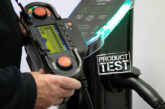
Pete Monfort, Director of Arena Training Centre and Monty Electrics, gets to grips with the IDEAL Industries EMEA SureTrace Circuit Tracer.
My Mum always used to say: “Men don’t grow up, their toys just get more expensive”, and how right she was, as illustrated by the excitement I felt when receiving my latest item for review – the SureTrace Circuit Tracer. Now this kit is not cheap, but I can assure you that it’s worth every penny.
The first thing I noticed was the rugged construction of the carry case and likewise the product within. Tough moulded rubber casings and good quality plastic means this equipment is likely going to be able to endure some punishment and continue working regardless. The transmitter unit is beefy and simple to use with ON/OFF, battery warning and voltage warning lights, while the heavier battery unit comes with a convenient strap. I found the receiver was easy to use and I liked how the screen automatically rotated regardless of the orientation – this is particularly useful when working in confined spaces.
Initially I decided to test the kit on circuits that were known to myself, so the Arena Training Centre basically became a test facility! Starting with the ‘Breaker Find’ function I did my best to fool this bit of kit but it gave a clear indication on every circuit I used, picking out the circuit breaker on the live circuit each time and even indicating which distribution board contained my breaker with a simple scan of the DB panel’s face. In fact, its accuracy was so impressive it was able to differentiate between two ring circuits that happen to be wired almost in parallel.
Anyone carrying out EICRs commercially will find this function immensely useful since it enabled quick and accurate identification of circuits.
Next I tried the ‘Cable Tracing’ function. I owned a rather cheap unit previously – which was very inconsistent – so I was a bit sceptical about how well the SureTrace would work in this area. Once again, it proved to be very accurate. When testing on cables run in deep trunking, I could pick out where the cable was sitting within the trunking. Steel conduit couldn’t fool this little device and even dead circuits could be traced by picking up an earth path with a crocodile clip and fly lead.
The ‘Cable ID’ function was up next, and I actually used this on a paying job. Having had my team pull in 20 network feeds they had (very helpfully) failed to label any of the cables – a potential nightmare. Not so with the SureTrace though, as by connecting the cable ends to the transmitter in the tracer and a local earthed point for a return path, the receiver picked the unknown end out from the bundle with a clear indication. A full bundle of 20 cables was identified in two minutes.
The ‘Open Circuit’ function was also excellent. To test this, I asked one of my students to disconnect a line conductor from one of the test rigs at the college. Initially I struggled to get the circuit finder to reveal the location of the open circuit but, after re-reading the instructions and understanding how the equipment actually works, I eliminated the problem of capacitive coupling. Repeating the search picked out the disconnection on the first sweep with pinpoint accuracy.

While I was at it, I also had a play with the inductive clamp which induces a signal into a circuit (or even metal conduit) and allows the tracing of live circuits. This is a useful feature given that customers do like to demand that equipment isn’t switched off for testing. I actually used this on a test at my own property with a bank of sockets that were not marked up and lacking adequate labelling. The clamp introduced a signal which was clearly discernible and allowed the socket faces to be quickly identified across two circuits.
The conduit tracer worked too, and a length of metal conduit was set up in our training centre and covered in boards to see if we could detect the path of conduit through a thick layer of timber. The sensitivity was such that the exact route could be chalked out on the timber panels, something that hugely impressed all those observing.
Overall, I found this device to be extremely useful and I feel as if I’ve only really scratched the surface in terms of its scope of use. You do need to take some time to play with it, understand it and get a feel for how it works, and I found that reducing the unit’s sensitivity regularly would achieve really clear indications. Of course, the spare sensitivity means it will still work in more arduous circumstances but, nevertheless, it took a short while to get the hang of it.
My opinion is that any electrician undertaking EICRs – from domestic to commercial – would seriously benefit from owning this product and I can assure you that it would quickly pay back the initial outlay on purchase. It gets top marks from me!









